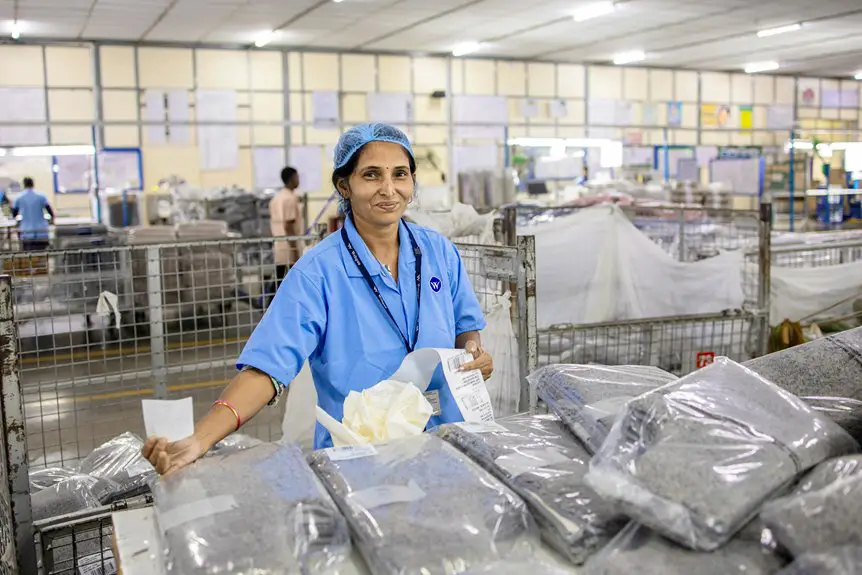Achieving supply chain transparency in textiles isn’t as simple as it seems. You face a web of complexities, where fragmented networks and outdated technologies create significant hurdles. As you navigate this landscape, you’ll find that ethical practices and sustainability often take a backseat. The question remains: what steps can be taken to bridge these gaps and meet the growing demands for transparency? Let’s explore the underlying challenges and potential solutions.
Table of Contents
Key Takeaways
- The complexity of global supply chains involves multiple countries and stakeholders, complicating tracking and communication.
- Traditional tracking systems often leave gaps in information, leading to inaccuracies about product origins and practices.
- Diverse regulations and compliance requirements across regions create challenges for businesses in maintaining transparency.
- Many suppliers struggle to adopt new technologies, hindering real-time data sharing and collaboration among stakeholders.
- Consumer demand for ethical practices increases pressure on brands, yet lack of transparency can conceal exploitation and environmental harm.
The Complexity of Globalized Supply Chains
As you explore the world of textiles, you’ll quickly realize that the complexity of globalized supply chains can be intimidating. Multiple countries often contribute different components, from raw materials to finished goods. Each step involves various stakeholders—suppliers, manufacturers, and distributors—making it challenging to track the flow of products.
You’ll encounter various regulations, cultural norms, and logistical hurdles that can complicate processes further. Additionally, fluctuations in demand and supply can create unexpected disruptions, adding to the chaos.
Understanding these interconnected systems is essential for fostering transparency and accountability in the textile industry. By grasping the intricacies of global supply chains, you can make informed decisions that not only enhance your business but also promote sustainable practices within the industry.
Challenges of Fragmented Supplier Networks
While traversing the textile industry, you’ll quickly discover that fragmented supplier networks pose significant challenges.
With multiple suppliers scattered across various regions, tracking materials and ensuring compliance becomes a challenging task. You might find it difficult to maintain consistent communication and quality standards, leading to potential delays and increased costs.
Each supplier may have different practices, complicating your efforts to establish uniformity in transparency. Additionally, the lack of centralized data can hinder your ability to assess sustainability practices effectively.
You’ll likely struggle to build trust with consumers, as they demand more information about sourcing and labor conditions. Maneuvering this fragmented landscape requires strategic collaboration and a clear understanding of each supplier’s role in the supply chain.
Technological Barriers to Transparency
When you consider supply chain transparency, technological barriers can really complicate things.
Traditional tracking systems often fall short, leaving gaps in information that hinder visibility.
Plus, many suppliers struggle to adopt new technologies, making it even tougher to achieve full transparency.
Traditional Tracking Limitations
Although many companies aim for supply chain transparency in the textile industry, traditional tracking methods often hinder their efforts. These outdated systems rely on manual processes and paper records, making it difficult to gather real-time data. You might find discrepancies in information, and that can lead to confusion about product origins and practices. Additionally, the lack of integration between various stakeholders complicates data sharing.
| Limitation | Impact on Transparency | Possible Solution |
|---|---|---|
| Manual Processes | Inaccurate data | Implement digital tracking |
| Paper Records | Slow information flow | Use cloud-based solutions |
| Disparate Systems | Poor collaboration | Standardize platforms |
| Limited Real-Time Data | Delayed decision-making | Adopt IoT technology |
Adoption Challenges for Suppliers
As suppliers attempt to embrace transparency in the textile supply chain, they often encounter significant technological barriers that hinder their progress.
These challenges can feel overwhelming, but recognizing them is the first step toward finding solutions.
Here are three key barriers you might face:
- Legacy Systems: Many suppliers rely on outdated software that doesn’t integrate well with modern tracking technologies, making it tough to share real-time data.
- Data Complexity: The sheer volume and variety of data from multiple sources can make it difficult to maintain accurate records and guarantee consistency across the supply chain.
- Cost of Implementation: Upgrading to advanced tracking systems can be prohibitively expensive, especially for smaller suppliers who may lack the necessary resources.
Ethical and Environmental Implications
Supply chain transparency in textiles isn’t just a buzzword; it carries significant ethical and environmental implications that affect everyone involved, from consumers to manufacturers.
When you understand where your clothing comes from, you can make informed choices that align with your values. Ethical practices, like fair labor conditions and sustainable sourcing, become easier to support when transparency exists.
Conversely, a lack of transparency often hides exploitation and environmental degradation, compromising the health of communities and ecosystems.
By demanding clearer supply chains, you encourage brands to adopt responsible practices. This shift not only fosters social equity but also helps reduce environmental impact, prompting companies to prioritize sustainability.
Ultimately, your choices can drive positive change in the textile industry.
Navigating Regulatory and Compliance Frameworks
As you navigate the complex landscape of supply chain transparency in textiles, you’ll encounter diverse global regulations that can feel overwhelming.
Each country has its own compliance requirements, placing additional reporting burdens on suppliers.
It’s essential to stay informed and adapt your strategies to meet these varying standards effectively.
Diverse Global Regulations
Steering through the complex landscape of diverse global regulations can feel overwhelming for businesses in the textile industry. Each country has its own set of rules, and maneuvering these can be tricky.
Here are three key aspects to take into account:
- Local Compliance: Understand the specific regulations in each market to avoid penalties and guarantee smooth operations.
- Sustainability Standards: Familiarize yourself with environmental laws and social responsibility guidelines that may affect sourcing and production practices.
- Trade Agreements: Stay updated on international agreements that can influence tariffs, import/export restrictions, and overall costs.
Reporting Burdens on Suppliers
While maneuvering through the maze of regulatory and compliance frameworks, you might find that reporting burdens on suppliers have increased substantially.
Suppliers are often overwhelmed by the myriad of requirements, from environmental standards to labor practices. Each regulation demands precise data and documentation, which can be time-consuming and costly. This pressure can lead to delays in reporting and may compromise the quality of information provided.
Additionally, smaller suppliers may struggle to keep up, risking non-compliance. As a result, fostering transparency becomes a challenging balancing act.
You’ll need to support your suppliers in traversing these complexities, ensuring they understand their obligations while maintaining efficient operations. Only then can you create a more transparent and responsible supply chain in the textile industry.
The Role of Innovation in Enhancing Transparency
Innovation plays a critical role in enhancing transparency within the textile supply chain, as it empowers brands and consumers alike to access essential information about sourcing and production processes.
By leveraging new technologies, you can gain insights that were previously hard to uncover. Here are three ways innovation drives transparency:
- Blockchain Technology: This decentralized ledger allows you to track every step of the textile journey, ensuring authenticity and accountability.
- Digital Platforms: These tools create a direct line of communication between you and suppliers, making it easier to share information and verify practices.
- Data Analytics: With advanced analytics, you can monitor supply chain performance in real-time, identifying potential risks and inefficiencies that need addressing.
Embracing these innovations promotes a more transparent and sustainable textile industry.
Building Trust With Suppliers
Building strong relationships with suppliers is essential for fostering trust in the textile supply chain. You should prioritize open communication, ensuring both sides feel comfortable sharing information.
Regular check-ins and feedback loops can help you address concerns before they escalate. When you demonstrate reliability by meeting deadlines and honoring agreements, you’re not just building trust; you’re solidifying partnerships.
Transparency about your expectations and challenges encourages suppliers to reciprocate, creating a collaborative environment. Consider involving them in decision-making processes to strengthen their commitment.
The Impact of Consumer Awareness
As consumers become more informed about the environmental and ethical implications of their purchases, their demand for transparency in the textile industry grows.
This heightened awareness pushes brands to adopt clearer supply chain practices. You play an essential role in this movement, influencing how companies operate.
Here are three ways your awareness impacts the industry:
- Informed Choices: You can choose brands that prioritize ethical sourcing and sustainable practices, driving others to follow suit.
- Accountability: When you ask questions about where and how products are made, companies are more likely to provide truthful answers.
- Community Engagement: Your voice in discussions about transparency can inspire others to advocate for change, creating a collective demand for responsible practices.
Together, you can shape a more ethical textile industry.
Future Directions for Supply Chain Transparency
The growing demand for transparency in the textile industry is shaping its future direction.
You’ll notice brands increasingly prioritizing ethical sourcing and sustainable practices. As consumers, you’re driving this change by seeking information about where and how your clothes are made.
Companies are adopting technologies like blockchain to provide real-time data about their supply chains, ensuring authenticity and accountability.
Collaborations between brands, NGOs, and governments are emerging to establish industry-wide standards. You can expect more brands to share their supply chain stories, making it easier for you to make informed choices.
Ultimately, this shift towards transparency isn’t just a trend; it’s a necessary evolution that’ll reshape the entire industry, enhancing trust and fostering a more sustainable future in textiles.
Frequently Asked Questions
What Are the Costs Associated With Achieving Supply Chain Transparency?
Costly challenges come with achieving transparency. You’ll face expenses like technology upgrades, training teams, and auditing processes. These financial factors can strain budgets, but investing in transparency often leads to long-term benefits and better brand reputation.
How Do Consumers Influence Supply Chain Practices?
You influence supply chain practices by demanding ethical products, supporting brands that prioritize transparency, and sharing your values on social media. Your choices and voice drive companies to adopt more responsible sourcing and production methods.
What Role Do Certifications Play in Supply Chain Transparency?
Certifications enhance supply chain transparency by establishing trust. When you see recognized labels, you know companies adhere to standards. This encourages ethical practices, making it easier for you to choose responsible brands and support sustainable initiatives.
Can Smaller Companies Achieve Transparency Without Significant Investment?
Yes, smaller companies can achieve transparency without huge investments. You can leverage technology, collaborate with suppliers, and focus on open communication. These strategies often require creativity and commitment, but they’re effective in enhancing transparency.
What Are the Main Barriers to Adopting Blockchain Technology?
You’ll find that the main barriers to adopting blockchain technology include high implementation costs, lack of technical expertise, resistance to change, and concerns over data privacy. These challenges can hinder your organization’s ability to innovate effectively.
- How to Safely Clean a Fabric Tablet Case With Leather Trim - June 25, 2025
- Cleaning Your Speck Fabric Iphone Case: the Official Guide - June 25, 2025
- How to Deep Clean a Fabric Guitar Case Interior - June 25, 2025




